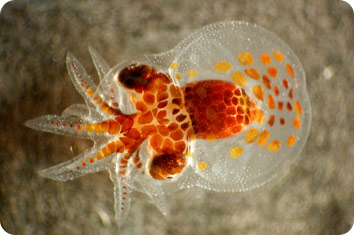Octopi, squids, and cuttlefishes, collectively known as cephalopods, are intelligent invertebrates that have the ability to change the color of their skin. One reason they change color is to camouflage themselves from predators and prey.
 Larval octopus. Chromatophores are visible even at this young stage. Photo: Matt Wilson/Jay Clark, National Oceanic and Atmospheric Administration
Larval octopus. Chromatophores are visible even at this young stage. Photo: Matt Wilson/Jay Clark, National Oceanic and Atmospheric AdministrationBut, they also use changes in color to communicate. Communication is critical for animals because it can help them reproduce or survive. These particular cephalopods use color signals to exchange information about mating, aggression, or danger.
Color-changing cephalopods produce a wide range of colorful displays such as subtle dark shimmering, conspicuous black and white stripes, or turning the entire body bright red. Some squids can produce two signals at once so that one side of the body signals aggression while the other side signals attraction. How do they manage such fine control of their color?
Their skin is covered with organs called chromatophores. Each chromatophore is made up of muscles arranged in a circle around a sac of pigment. When the muscles contract, the sac is stretched open, revealing the color inside, and when the muscles relax, the sac will close, hiding the color. Because these muscles are controlled by the nervous system, cephalopods can change their color and pattern very quickly and in isolated areas.
Color patterns are the most obvious part of cephalopod communication, but they are used in combination with other visible changes to create signals. Some species control body posture, others control skin texture, and most have reflective cells that add extra colors to their chromatophore patterns.
Such complex invertebrate communication is exciting for scientists who study the evolution of behavior, because it allows them to compare how very different kinds of animals have solved some of life’s common challenges.
Copyright 2007, The University of Texas Marine Science Institute


